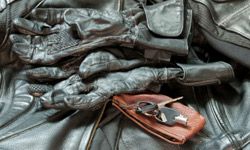In a motorcycle crash, the only thing between you and the pavement is what you're wearing. Body armor absorbs impact, and the material your clothing is constructed of provides abrasion resistance. Making sure you have both kinds of protection is important.
To tell if your apparel makes the grade, look for a CE approval mark, a test standard in Europe for motorcyclist clothing. The CE approval process includes rigorous tests on garments to measure their armor effectiveness, seam strength and outer materials' abrasion resistance. The CE mark functions much like the Snell helmet approval system in the United States.
Advertisement
Leather, the ever-popular choice for motorcycle apparel, stands up well to CE testing. Among the different leathers, the most common material is cowhide, which is used because of its strength and durability. Motorcycle-rated cowhide leather that is at least 1.3 millimeters thick provides the best crash protection of any material and is the choice for racing suits. Fashion leather is often made from a less expensive hide, such as sheepskin, and provides less abrasion protection, so you'll want to make sure your leather clothing is reinforced in critical areas, such as your butt, back, knees, elbows and shoulders.
Leather offers many advantages over other materials used for motorcycle apparel. It provides classic styling that doesn't look dated. That's a good thing because it can last as long as 30 years when cared for properly. Leather also doesn't show dirt.
On the flip side, leather is heavy and can be uncomfortable in warm weather. Its dark color affects visibility. Leather is not waterproof, and it must be treated to keep it soft. In spite of these disadvantages, leather is a sensible choice for motorcycle apparel, but it's not the only choice.
Advertisement


